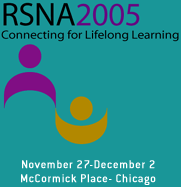
Abstract Archives of the RSNA, 2005
John Lackey MS, Presenter: Nothing to Disclose
Song Lai PhD, Abstract Co-Author: Nothing to Disclose
Adam Eugene Flanders MD, Abstract Co-Author: Nothing to Disclose
Scott Enochs, Abstract Co-Author: Nothing to Disclose
Yuan-Yu Hsu, Abstract Co-Author: Nothing to Disclose
Ho-Ling Liu PhD, Abstract Co-Author: Nothing to Disclose
Jiangxi Xiao, Abstract Co-Author: Nothing to Disclose
Zhi Wang, Abstract Co-Author: Nothing to Disclose
et al, Abstract Co-Author: Nothing to Disclose
Quantitative perfusion MRI using dynamic susceptibility contrast (DSC) requires estimation of arterial input function (AIF). We evaluated the performance of a computerized AIF selector (CAIFS) by comparing perfusion images derived from CAIFS with those derived from AIFs that radiologists identified manually.
One normal (22 years), four brain tumor patients (42.25±19.00 years) and five ischemic stroke patients (61.60±13.96 years) were scanned using a 1.5T clinical MRI system. The perfusion scan used a single-shot SE EPI sequence (TR/TE = 1.5s/60ms) covering seven 6-mm oblique-axial slices with the lowest slice containing the MCA. The sequence was repeated 60 times continuously, with intravenous bolus injection of Gd-DTPA (5 ml in 1 second) being administered at 7th scan.
The three experienced radiologists identified multiple vessels in multiple slices in each subject. In only three of the nine subjects did all three radiologists identify the same artery for the AIF. Overall, CAIFS identified 80% of the arteries identified by the radiologists. In addition to these vessels, CAIFS identified 30 other arteries that were later confirmed by the radiologists. CBF maps generated by CAIFS and the radiologists-chosen AIFs, from MCA or ICA, are very similar and show no significant difference in any area of the brain, as further confirmed by scatter plots of the values of the CBF maps derived using the AIFs defined by CAIFS and the radiologists, with a mean Pearson correlation coefficient of r=0.932±0.087. Comparing CBF maps produced by the radiologists gave a mean r=0.920±0.075. The temporal resolution of MRI was too coarse to detect differences in time-to-peak along the same arteries (e.g. MCA). Therefore, all voxels along the same artery could be used for the AIF. One salient advantage of CAIFS is that arterial vessels identified in different brain areas can be used as local AIFs to generate more accurate perfusion maps, especially in ischemic stroke patients.
A robust algorithm for computerized identification of AIF for DSC-MRI perfusion has been developed. The current comparison fully demonstrated that it performs as well as experienced radiologists.
Quantitative perfusion MRI using dynamic susceptibility contrast (DSC) requires estimation of arterial input function (AIF). We evaluated the performance of a computerized AIF selector (CAIFS) by comparing perfusion images derived from CAIFS with those derived from AIFs that radiologists identified manually.
One normal (22 years), four brain tumor patients (42.25±19.00 years) and five ischemic stroke patients (61.60±13.96 years) were scanned using a 1.5T clinical MRI system. The perfusion scan used a single-shot SE EPI sequence (TR/TE = 1.5s/60ms) covering seven 6-mm oblique-axial slices with the lowest slice containing the MCA. The sequence was repeated 60 times continuously, with intravenous bolus injection of Gd-DTPA (5 ml in 1 second) being administered at 7th scan.
The three experienced radiologists identified multiple vessels in multiple slices in each subject. In only three of the nine subjects did all three radiologists identify the same artery for the AIF. Overall, CAIFS identified 80% of the arteries identified by the radiologists. In addition to these vessels, CAIFS identified 30 other arteries that were later confirmed by the radiologists. CBF maps generated by CAIFS and the radiologists-chosen AIFs, from MCA or ICA, are very similar and show no significant difference in any area of the brain, as further confirmed by scatter plots of the values of the CBF maps derived using the AIFs defined by CAIFS and the radiologists, with a mean Pearson correlation coefficient of r=0.932±0.087. Comparing CBF maps produced by the radiologists gave a mean r=0.920±0.075. The temporal resolution of MRI was too coarse to detect differences in time-to-peak along the same arteries (e.g. MCA). Therefore, all voxels along the same artery could be used for the AIF. One salient advantage of CAIFS is that arterial vessels identified in different brain areas can be used as local AIFs to generate more accurate perfusion maps, especially in ischemic stroke patients.
A robust algorithm for computerized identification of AIF for DSC-MRI perfusion has been developed. The current comparison fully demonstrated that it performs as well as experienced radiologists.
Lackey, J,
Lai, S,
Flanders, A,
Enochs, S,
Hsu, Y,
Liu, H,
Xiao, J,
Wang, Z,
et al, ,
Automatic versus Physician Selected Arterial Input Functions for Perfusion MRI. Radiological Society of North America 2005 Scientific Assembly and Annual Meeting, November 27 - December 2, 2005 ,Chicago IL.
http://archive.rsna.org/2005/4412674.html

